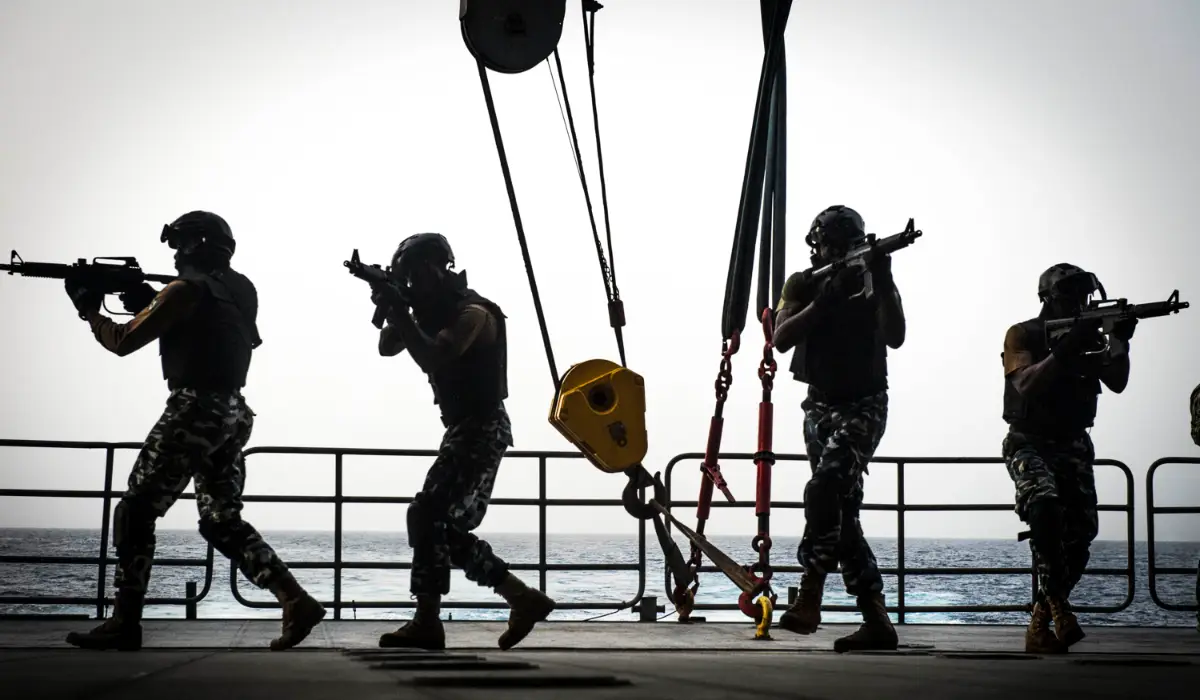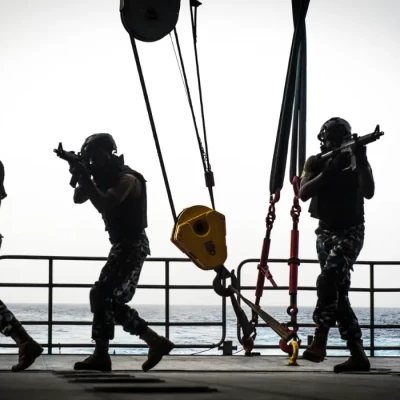The Gulf of Guinea (GoG) emerges as a focal point of global concern due to escalating maritime insecurity, encompassing rampant illegal, unreported, and unregulated fishing, piracy, armed robbery, and oil-related crimes. This tumultuous maritime environment has weathered ongoing challenges over time, necessitating a meticulous examination of its security landscape. Beyond the pervasive issues, the GoG faces multifaceted threats, including geopolitical complexities, economic vulnerabilities, and environmental concerns. The intertwining of these factors amplifies the region’s susceptibility to maritime crimes and the urgency of comprehensive security measures.
Episodes of maritime piracy in West Africa have thrust the region into the spotlight, shedding light on the adaptability of criminal entities. A retrospective analysis of 2021 reveals a notable 54% reduction in overall piracy and maritime crime,1Dryad Global (n.d.) ‘Where have the pirates gone?: Maritime Security in West Africa’, Available at: https://www.dryadglobal.com/west-africa-piracy-where-have-the-pirates-gone [Date accessed: 18 February 2024]. indicating a positive trend from the preceding year. Nonetheless, delving deeper into the intricacies of specific incidents, their modus operandi and the identities of involved groups is imperative. As stakeholders grapple with these challenges, an unambiguous understanding of the region’s maritime vulnerabilities is paramount. This paper unveils critical insights into the ever-evolving dynamics of maritime threats in the GoG.
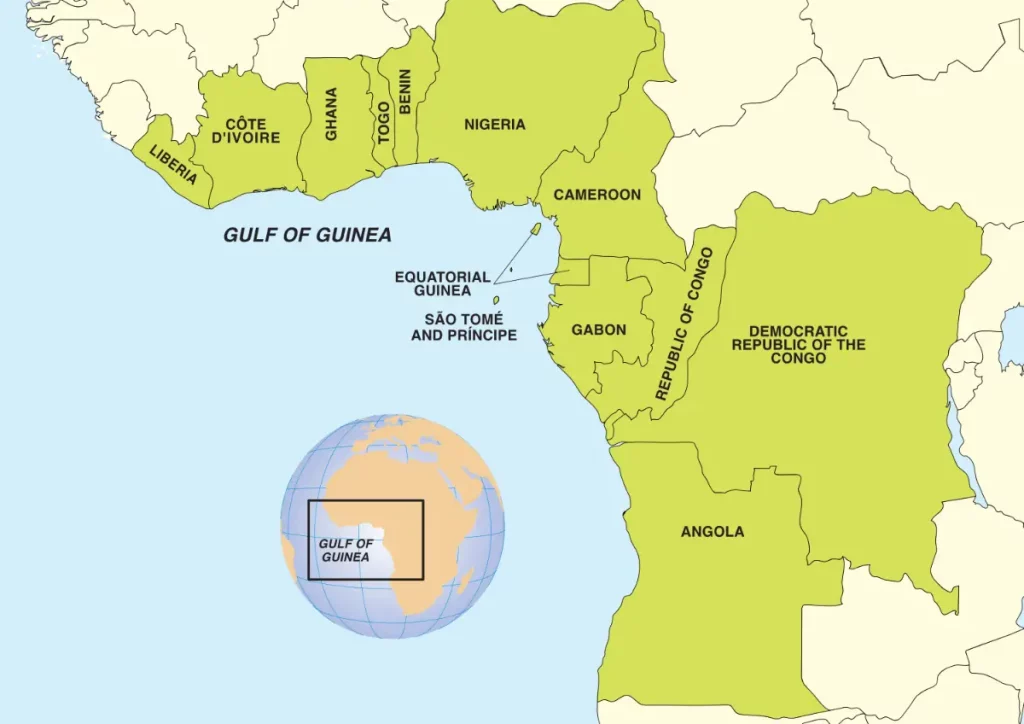
Role of MSCs in the ECOWAS maritime domain
The operationalisation of maritime security centres (MSCs) within the Economic Community of West African States (ECOWAS) maritime domain represents a landmark initiative aimed at fortifying regional maritime security. These MSCs serve as strategic hubs for coordinating and executing maritime safety measures, reflecting a collective commitment to addressing the complex challenges prevalent in the GoG. The establishment of these centres underscores the recognition of the interconnected nature of maritime threats, necessitating a unified response.
By fostering information-sharing, joint planning, and collaborative conduct, ECOWAS has fostered an environment conducive to mitigating piracy and sea robbery incidents. This collective approach enhances situational awareness and response capabilities, a testament to the effectiveness of regional cooperation. Notably, it has contributed to a decrease in piracy and sea robbery incidents, indicating the positive impact of regional collaboration and coordinated efforts.2Fisheries Committee for the West Central Gulf of Guinea (2023) ‘FCWC Participates in ECOWAS Maritime Security Architecture Stakeholders Meeting’, Available at: https://fcwc-fish.org/our-news/fcwc-participates-in-ecowas-maritime-security-architecture-stakeholders-meeting [Date accessed: 2 February 2024].
The positive outcomes, particularly the notable decrease in piracy and sea robbery incidents, underscore the tangible impact of the MSCs. This success is indicative of the synergy achieved through shared resources, intelligence, and coordinated operations. The collaborative efforts reveal a paradigm shift from individual state-centric approaches to a comprehensive, regional strategy. Furthermore, the operationalisation of these centres reflects a broader commitment to maritime security governance, aligning with international best practices. The ECOWAS maritime domain has become a testament to the dividends of proactive regional engagement, setting a precedent for other maritime regions globally. In essence, the operationalisation of MSCs within ECOWAS has not only addressed immediate security concerns but has also laid the foundation for sustained collaboration, capacity-building, and the promotion of a secure and stable maritime environment in West Africa.
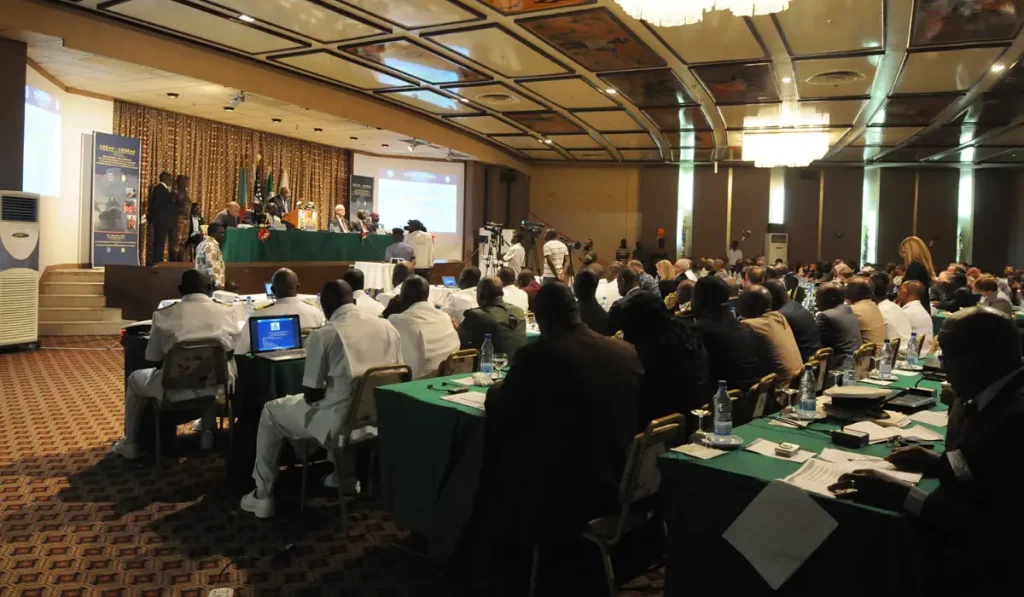
Technology advancements for improved maritime security
African navies and their international partners are leveraging technology to enhance safety and security in the GoG. Opportunities provided by technological advancements play a crucial role in mitigating maritime threats. This includes the utilisation of advanced surveillance systems and communication technologies for early detection and response.3Okafor-Yarwood, I. & Eastwood, L. (2024) ‘Technology and maritime security in Africa: Opportunities and challenges in Gulf of Guinea’, Maritime Domain News, Available at: https://www.gogin.eu/en/maritime-domain-news/technology-and-maritime-security-in-africa-opportunities-and-challenges-in-gulf-of-guinea [Date accessed: 12 February 2024]. The multifaceted approach to leveraging technology encompasses a spectrum of opportunities that collectively contribute to mitigating maritime threats in this vital region. The technology used includes the following:
- Surveillance systems: Advanced surveillance technologies have become instrumental in monitoring vast maritime expanses. High-resolution cameras, satellite imagery, and unmanned aerial vehicles (UAVs) are deployed to enhance situational awareness. These systems enable real-time monitoring of maritime activities, allowing authorities to identify and assess potential threats promptly.
- Communication technologies: Seamless communication is paramount for effective maritime security. The integration of sophisticated communication technologies ensures swift and secure information exchange between naval forces, coast guards, and international partners. This interconnected network facilitates coordinated responses to emerging threats, fostering a more agile and collaborative security environment.
- Early detection and response: The utilisation of technology facilitates early detection of suspicious activities, enabling proactive intervention. Automated systems equipped with artificial intelligence (AI) analyse patterns and anomalies, enhancing the ability to discern potential threats. This early detection capability significantly reduces response times, enabling more efficient and targeted countermeasures.
- International collaboration: Technology serves as a bridge for international collaboration, allowing seamless coordination between African navies and their global partners. Shared platforms for information exchange, joint training exercises, and collaborative research initiatives enhance the collective capacity to address complex maritime challenges.
- Capacity building: The integration of technology necessitates continuous capacity-building efforts. Training programmes focus on enhancing the technical proficiency of naval personnel in utilising and maintaining advanced equipment. This investment in human capital ensures the sustainable and effective implementation of technological solutions.
- Adaptability to evolving threats: The flexibility of technological solutions allows for adaptability to evolving threats. As maritime threats continue to change, the integration of emerging technologies, such as machine learning and predictive analytics, ensures that security measures remain dynamic and responsive to the evolving nature of challenges.
The comprehensive adoption of technology by African navies and their international partners not only enhances safety and security in the GoG, but also represents a paradigm shift towards a more collaborative, proactive, and technologically driven approach to maritime governance.
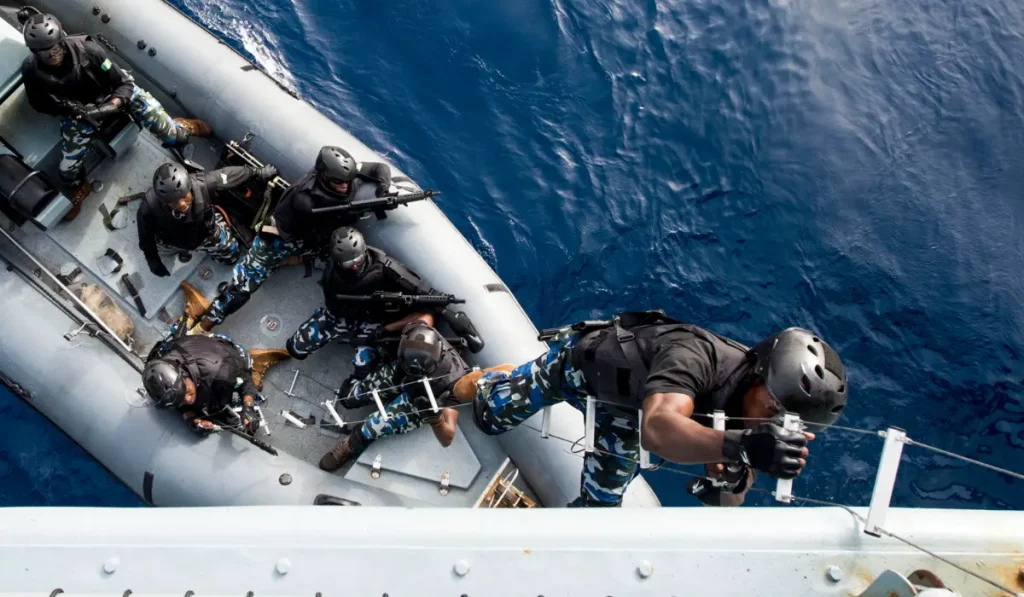
Positive trends and challenges in maritime security
Despite the positive progress observed in the reduction of incidents, challenges persist. The GoG experienced a decline in incidents from 45 in 2021 to 11 in 2022.4Dryad Global (2024) ‘Dryad Global Annual Report: Key Challenges Facing the Gulf of Guinea’, Available at: https://channel16.dryadglobal.com/dryad-global-annual-report-key-challenges-facing-the-gulf-of-guinea [Date accessed: 2 February 2024]. However, recent trends suggest a shift, necessitating continued efforts to address emerging challenges in the dynamic maritime security landscape.5Amani Africa (n.d.) ‘Briefing on Maritime Security in the Gulf of Guinea’, Available at: https://amaniafrica-et.org/briefing-on-maritime-security-in-the-gulf-of-guinea [Date accessed: 2 February 2024]. A comprehensive examination of maritime security in the GoG reveals both positive developments and persistent challenges. The effectiveness of MSCs, technological advancements, and regional collaboration are crucial elements in ensuring a secure maritime environment in West Africa.
The GoG witnessed a substantial decline in maritime incidents between 2021 and 2022. While this reduction initially signalled progress in the region’s maritime security, recent trends indicate a shift that demands sustained attention and proactive measures. The evolving nature of challenges necessitates continued efforts to address emerging threats in the dynamic maritime security landscape. Positive developments in this area include:
- Decline in incidents: The significant reduction in reported incidents from 2021 to 2022 highlights the initial success of the GoG’s maritime security efforts.
- Effectiveness of MSCs: MSCs have played a pivotal role in enhancing security. Their effectiveness is evident in the notable decrease in piracy and armed robbery incidents.
- Technological advancements: The adoption of advanced technologies, such as surveillance systems and communication tools, has contributed to improved early detection and response capabilities, fostering a safer maritime environment.
- Regional collaboration: Collaborative efforts among GoG countries and international partners have strengthened regional coordination, facilitating a unified response to maritime threats.
Persistent challenges faced in the GoG are described below:
- Emerging trends: Recent shifts in maritime incidents suggest the emergence of new challenges, requiring a nuanced and adaptive approach to security measures.
- Need for continued vigilance: The decline in incidents should not breed complacency. Continuous vigilance and proactive measures are essential to stay ahead of evolving threats.
- Capacity building: Ongoing efforts are needed to enhance the capacity of maritime forces, ensuring they are well-equipped to address emerging challenges effectively.
- Socioeconomic factors: Addressing the root causes of maritime insecurity, including socioeconomic issues, is crucial for long-term stability in the GoG.
While positive developments indicate progress, acknowledging and addressing persistent challenges is paramount. The collective effectiveness of MSCs, technological advancements, and regional collaboration remains integral to securing the maritime environment in West Africa. A comprehensive and adaptive strategy is imperative to navigate the evolving dynamics of maritime security in the GoG.
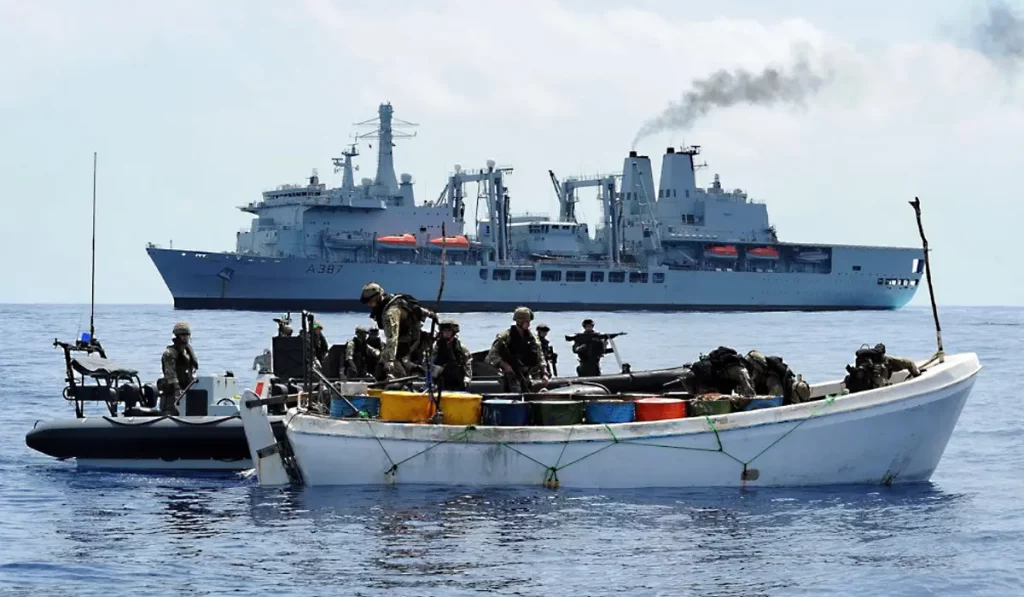
Analysing maritime security trends in West Africa
Maritime security in West Africa has witnessed notable changes, with a decline in piracy incidents. In 2021, the region experienced a 54% reduction in overall piracy and maritime crime compared to 2020, highlighting positive strides in combating maritime threats.6Dryad Global (2024) ‘West Africa Piracy: where have the pirates gone?’ Available at: https://www.dryadglobal.com/west-africa-piracy-where-have-the-pirates-gone [Date accessed: 12 February 2024]; Iyayi, F. & Oluwaseun, O. (2019) ‘Maritime Piracy, Military Capacity, and Institutions in the Gulf of Guinea’, Defense and Security Analysis, 35(4), 327–341, DOI: 10.1080/09546553.2019.1659783. However, this progress does not diminish the persisting challenges, as the GoG remains a hotspot for maritime insecurity.7Okafor-Yarwood, I., Eastwood, O., Chikowore, N., & de Oliveira Paes, L. (2024) ‘Technology and maritime security in Africa: Opportunities and challenges in Gulf of Guinea’, Marine Policy, 160, 105976. Global piracy rates have experienced a decline, reaching a low of 131 incidents in 2022.8Kreier, F. (2024) ‘Piracy at sea is waning – but hotspots remain’, Nature, 17 January, Available at: https://doi.org/10.1038/d41586-024-00124-6. Advanced technologies have played a crucial role in this improvement, aiding in the identification, capture, and prosecution of criminals at sea.9Okafor-Yarwood, I. et al. (2024) ‘Technology and maritime security in Africa’, op. cit.
Analysing the interplay of technology, cyber threats, and maritime security in West Africa
Utilisation of technology for improving safety and security
The incorporation of cutting-edge technologies stands as a cornerstone in fortifying safety and security within maritime domains. Research findings underscore the pivotal role of technologies like radar, satellite systems, and advanced communication tools in effectively monitoring and safeguarding maritime activities and transforming the maritime landscape. The utilisation of these innovations empowers maritime stakeholders with enhanced surveillance capabilities, early threat detection mechanisms, and improved response strategies.10Johri, S. & Krishnan, S. (2019) ‘Piracy And Maritime Security: Regional Characteristics and Political, Legal and Economic Implications’, World Affairs: The Journal of International Issues, 23(3), 80–101, Available at: https://www.jstor.org/stable/48531052. Research findings also highlight their significance in effectively monitoring and safeguarding maritime activities, making them indispensable components of modern maritime security frameworks.
Radar systems provide comprehensive surveillance, offering real-time tracking of vessels and potential threats. Their ability to detect objects on the sea surface, including ships and obstacles, enhances situational awareness for maritime stakeholders. Satellite technology contributes to maritime reconnaissance by providing high-resolution imagery, tracking vessel movements, and monitoring vast oceanic areas. This capability is crucial for identifying potential security threats and ensuring timely responses. Cutting-edge communication tools facilitate seamless information exchange among maritime stakeholders. This includes ship-to-ship communication, shore-based communication, and integration with maritime operation centres. Enhanced communication capabilities contribute to effective coordination and response strategies.
The utilisation of these technologies empowers maritime stakeholders with enhanced surveillance capabilities. The combination of radar and satellite systems allows for comprehensive coverage, reducing blind spots and vulnerabilities in maritime domains. The real-time data provided by these technologies enables early threat detection. Maritime security personnel can identify suspicious activities, potential piracy threats, or unauthorised vessel movements promptly, allowing for proactive measures to be taken.
The integration of cutting-edge technologies enhances the effectiveness of response strategies. Quick and accurate information dissemination, facilitated by advanced communication tools, enables timely and coordinated responses to maritime incidents, contributing to overall security. The strategic incorporation of radar, satellite systems, and advanced communication tools strengthens safety and security within maritime domains. These innovations not only elevate surveillance capabilities, but also empower maritime stakeholders with the tools needed for early threat detection and improved response strategies in the dynamic maritime environment.

Cyber threats in maritime environments
In the dynamic contemporary maritime landscape, the escalating threat of maritime cyber risks presents a significant and multifaceted challenge. This complex menace infiltrates both Information Technology (IT) and Operational Technology (OT) systems, creating vulnerabilities that jeopardise the integrity, availability, and confidentiality of critical maritime infrastructure. The spectrum of cyber threats spans from vital bridge systems to the intricate web of cargo handling and management systems, necessitating a comprehensive and proactive approach to fortify maritime cybersecurity defences. Maritime cyber risks encompass a broad array of potential threats, including, but not limited to, malware attacks, ransomware incidents, and sophisticated cyber espionage. The interconnected nature of maritime systems makes them susceptible to exploitation, requiring a holistic understanding of vulnerabilities. These cyber risks pose a direct threat to the integrity of maritime systems, potentially compromising navigation controls, communication channels, and essential operational components. The availability of critical services can be disrupted, leading to operational downtime and economic losses. Moreover, the confidentiality of sensitive maritime data is at stake, with potential breaches risking sensitive information related to vessel movements, cargo contents, and crew details.
From the foundational bridge systems that ensure safe navigation to the intricate web of cargo handling and management systems that streamline maritime logistics, the entirety of critical maritime infrastructure is susceptible to cyber threats. Securing these elements is paramount to maintaining the safety, efficiency, and reliability of maritime operations. To effectively counter these challenges, robust cybersecurity measures are imperative. This involves implementing advanced intrusion detection systems, regular vulnerability assessments, and continuous monitoring to identify and mitigate potential risks promptly. Additionally, cybersecurity training and awareness programmes for maritime personnel play a crucial role in creating a vigilant and resilient cybersecurity culture within the maritime industry. Addressing the multifaceted nature of maritime cyber risks requires a proactive and comprehensive cybersecurity approach. Safeguarding critical maritime infrastructure demands continuous efforts, collaboration, and investment in cutting-edge cybersecurity technologies to ensure the resilience of maritime operations in the face of evolving cyber threats.
Cyberpiracy: A growing menace
Cyberpiracy, an evolving menace, involves malicious activities strategically targeting vulnerabilities in maritime systems. Delving into the dynamics of cyberpiracy requires a comprehensive analysis of threat actors’ methodologies, ranging from sophisticated hacking techniques to phishing attacks. Unravelling these methods is crucial for understanding unauthorised access and control over maritime infrastructure. A sophisticated menace has emerged, orchestrating malicious activities with the strategic intent of exploiting vulnerabilities within maritime systems. Understanding the dynamics of cyberpiracy necessitates a thorough examination of the intricate methodologies employed by threat actors. This analysis encompasses a spectrum of techniques, from advanced hacking strategies to deceptive phishing attacks, all aimed at compromising the integrity of maritime infrastructure.
Threat actors’ methodologies
The sophisticated hacking techniques of cyber pirates are summarised below:
- Hacking: Cyber pirates employ cutting-edge hacking methodologies, leveraging advanced tools and techniques to breach maritime systems. This includes exploiting software vulnerabilities and conducting code injection attacks.
- Phishing attacks: Social engineering techniques play a pivotal role in cyberpiracy, with threat actors utilising deceptive phishing attacks. By masquerading as legitimate entities or leveraging targeted spear-phishing campaigns, cyber pirates aim to trick maritime personnel into divulging sensitive information or compromising system credentials.
- Malware deployment: Malicious software is prevalent in cyberpiracy and used to gain unauthorised access. Malware, ranging from ransomware to spyware, is strategically employed to infiltrate maritime systems, compromise data integrity, and potentially gain control over critical infrastructure.

Understanding unauthorised access
Unravelling these methods is paramount for comprehending the dynamics of unauthorised access and control over maritime infrastructure. Cyber pirates seek to exploit vulnerabilities, not only for financial gain, but also for strategic disruptions, potentially jeopardising the safety, security, and operational continuity of maritime activities.
Defence strategies
To counter the evolving threat of cyberpiracy, maritime stakeholders must adopt robust cybersecurity measures. This includes continuous monitoring, regular vulnerability assessments, employee training on cybersecurity best practices, and the implementation of advanced intrusion detection systems. The battle against cyberpiracy requires a proactive and comprehensive approach. By understanding the intricacies of threat actor methodologies, the maritime industry can fortify its defences, safeguard critical infrastructure, and ensure the resilience of maritime operations in the face of this evolving threat.
Impact on maritime operations and security
The repercussions of cyberpiracy extend beyond the digital realm, significantly impacting maritime operations and security. Cybersecurity breaches have the potential to disrupt navigation systems, instigate communication breakdowns, and compromise vessel safety. Addressing this growing threat mandates a comprehensive approach to mitigate risks and strengthen the resilience of maritime operations against evolving cyber threats. The surge in cyberpiracy poses a multifaceted threat to the maritime domain, transcending the digital boundaries to impact operational efficiency and security profoundly. Cybersecurity breaches in the maritime sector extend far beyond the compromise of data; they have the potential to disrupt critical navigation systems, instigate communication breakdowns, and jeopardise the safety of vessels at sea.
Navigation and communication systems disruption
Cyber intrusions can manipulate and compromise GPS and navigation systems, leading to inaccurate positioning information. Such disruptions not only impede vessel navigation, but also pose a significant risk of collisions, grounding, and other navigational accidents. Two aspects of navigation and communication systems disruption are:
- Communication breakdowns: Maritime operations heavily rely on seamless communication between vessels, ports, and authorities. Cybersecurity breaches can lead to communication breakdowns, hindering the exchange of vital information. This lack of communication can result in delays, misunderstandings, and an overall deterioration of operational effectiveness.
- Compromised vessel safety: The safety of vessels is paramount in the maritime industry. Cyber threats can compromise essential safety systems, such as engine controls, fire suppression systems, and navigation alarms. This compromises the overall safety of the vessel, leading to potential accidents, environmental hazards, and threats to human life.
Addressing the growing menace of cyberpiracy requires a comprehensive approach. This involves:
- Advanced cybersecurity measures: Implementing robust cybersecurity protocols, including firewalls, intrusion detection systems, and encryption, to safeguard critical maritime infrastructure.
- Regular training and awareness programmes: Educating maritime personnel about cybersecurity best practices to enhance their ability to identify and mitigate potential threats.
- Collaboration and information sharing: Fostering collaboration among maritime stakeholders, including shipping companies, port authorities, and international organisations, to share information and enhance collective cybersecurity resilience.
Fortifying the resilience of maritime operations against evolving cyber threats demands a concerted effort to integrate advanced technologies, personnel training, and collaborative strategies to ensure the safety, security, and efficiency of maritime activities in an increasingly digitised environment.
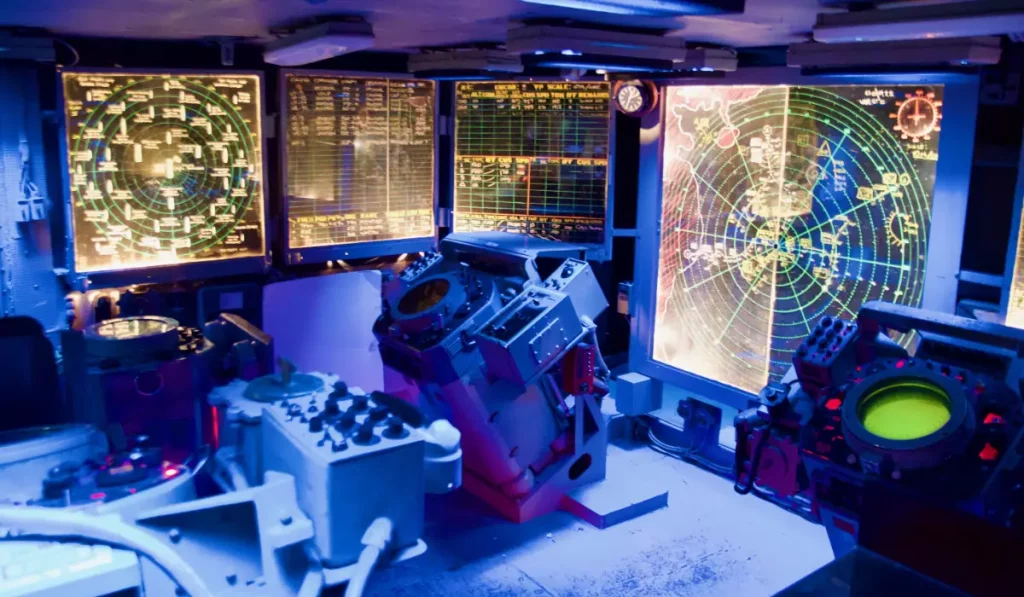
Conclusion
Navigating the complex waters of the GoG demands a comprehensive approach that intertwines regional cooperation, technological advancements, and robust cybersecurity measures. The rise of cyberpiracy introduces new challenges, emphasising the importance of understanding sophisticated threat actor methodologies and implementing proactive cybersecurity measures. While acknowledging the positive developments, persistent challenges necessitate continuous efforts. By embracing regional collaboration, leveraging technology, and fortifying cybersecurity defences, the maritime community can chart a course towards a secure, stable, and resilient future in the GoG and beyond.
Elsie Amelia Tachie-Menson is a Researcher and Editorial Associate at the Kofi Annan International Peacekeeping Training Centre (KAIPTC). With a solid background in Development Studies and currently pursuing a Master’s in Gender, Peace, and Security, she has dedicated six years to cybersecurity and four years to Maritime Security Studies. In her role, Elsie actively engages in policy dialogues with influential institutions such as the African Union, European Union, the Economic Community of West African States, the North Atlantic Treaty Organisation, MasterCard Foundation, CAMFED, and the United Nations Development Programme, contributing significantly to policy development and excellence in communication. Through her extensive experience, Elsie not only supports the development of policies but also fosters effective communication strategies that bridge the gap between research and practical application in the fields of peace, security, and governance.

